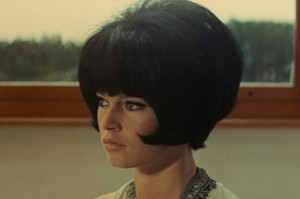In Profile: Ken Russell’s The Devils (1971)
Like your cult cinema weird, violent and controversial? Ahead of a screening at Cornerhouse, Adam Scovell explores Ken Russell’s most beautifully disturbing film…
By the time maverick British director Ken Russell came to make his most controversial film, he had already established himself as a creator of lavish, over-the-top eroticism of the highest calibre. Working through a series of innovative biographical films for BBC Monitor and Omnibus, he gradually moved on to stranger fictions such as Billion Dollar Brain (1967) and more popular (but equally controversial) fare such as his D.H. Lawrence adaptation, Women in Love (1969) and Tchaikovsky biography, The Music Lovers (1970).
From these films, it’s easy to attain a sense of where Russell was beginning to go with his filmmaking; camp, flamboyant excess but also classical, Gothic and art-house simultaneously.
Yet with all of these films, there’s simply no preparation available for his next move; an adaptation of Aldous Huxley’s The Devils of Loudun (1952) in the form of 1971′s The Devils. Even with Russell defining his sensibilities by heightening the sexuality in his previous films (the naked wrestling scene of Women in Love being an obvious example), there’s really no hint in his previous work at the excess that would be driven at in The Devils. It is, however, an excess that is apt for the narrative, the era of 1970s British film and the epitome of a very particular form of Albion-based controversy.
In spite of its obvious Englishness, The Devils is set in the town of Loudun in France during the 17th century. Like many English films set in the same era, elements of superstition and witchcraft play heavy on the sociological trends of the diegetic world. This superstition is used by the powerful Cardinal Richelieu (Christopher Logue) to bring down the town of Loudun and its nominated religious protector, Father Urbain Grandier (Oliver Reed).
With the ease in censorship and general regulations, British cinema of the 1970s saw a new lease of violent, sexual life. This can be seen in everything from the increase of nakedness in Hammer Horror, to more visceral, weird works finding their way into the mainstream, such as Nicolas Roeg and Donald Cammell’s Performance (1970), Robin Hardy’s The Wicker Man (1973), and Lindsay Anderson’s O’ Lucky Man (1973). Russell is, however, the defining moment of this era, which no doubt started in the depths of the counter-culture and free love movements of the mid 1960s.
This was a largely optimistic movement; so why is it then that only a handful of years later, the same ideas were being used to address some of the darkest themes cinema had sought to question?
In essence, The Devils shows the sheer lengths that authority will go to in order to silence the individual and the lower classes. This was another theme present in a whole host of British New Wave films from the ’60s but never more bloodily realised than in Russell’s film. The whole narrative revolves around a large scale conspiracy, brought about by the sexual repression of a nunnery (with Vanessa Redgrave leading the charge as the disturbingly lost Sister Jeanne), corrupted equally by solitude as by religion. This strange mixture of sexuality, torture and politics means that it is by far Russell’s most affecting film as well as his most provocative.
In spite of being a director that had already toyed with the blurred line between sex and death, Russell sought to persistently question the problem further within the cold, white walls of Loudun. These are the walls designed by Derek Jarman (see the Guardian’s recent profile piece here), with the eye of a visual artist whose future intents and controversies would mirror that of Russell’s. Very rarely can you read comment on the film without a particularly infamous line taken from Huxley’s original prose rearing its head in relation to Jarman’s work: comparing the exorcism of the sisters to a “rape in a public toilet” (hence the white tiled walls of the town with their horrible, wipe-clean aesthetic). A horrendous image definitely, but one that ultimately sums up the film as well as inspiring Jarman’s set design.
The nature of violence within the film is perhaps its most controversial point. The visuals of medieval torture had already proved a critical success in Michael Reeves’ Witchfinder General (1968), but here, there’s something more discomforting about it. On occasions, it resembles a cartoonish sense of violence with seemingly no boundaries conceivable, matched with a sense of the Gothic (squirming with the thought of a long, painful death a la Edgar Allen Poe).
Reed in particular plays his part well in this context, seemingly half dazed at the sheer nature of his fate (probably a mixture of performance and real-life boozing), and half writhen with terror at the sheer scale of what awaits him. Dreyer’s The Passion of Joan of Arc (1928) comes to mind when thinking in this area, but for Russell, this is merely a starting point to show the horrendous power of the rich and their natural leaning towards sadism.
In the end, The Devils is a better film than the sum of its controversies. The fact that Warner Brothers still won’t allow the full Russell cut to be available (the scenes in question extend the infamous ‘Rape of Christ’ sequence amongst others) leaves a bad taste, especially in a post-Irreversible (2002), post-Salò (1975) (named the 65th scariest film ever made by the Chicago Film Critics Association in 2006), and post-Antichrist (2009) world. It does however, also seem apt for a film about power and totalitarianism; its overall message of violence and extremism grounded in religious belief being the ultimate weapon in the ceaseless crusade against the individual and the freedom of will.
Adam Scovell
The Devils (1971), screening 2 June 2014 at Cornerhouse, Manchester as part of their Christianity, Controversy, Cinema Season





